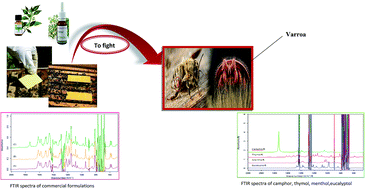Fourier transform infrared analysis of commercial formulations for Varroa treatment
Abstract
A comparative study has been carried out between univariate and multivariate calibration strategies for the simultaneous determination of camphor, thymol, menthol and eucalyptol in commercial formulations used for Varroa treatment. Absorbance peak heights of the transmission mid-infrared (MIR) spectra of individual monoterpenes, prepared in dichloromethane, were measured at 1737, 1151, 1022 and 980 cm−1 (corrected with a base-line at 1933 cm−1) for camphor, thymol, menthol and eucalyptol, respectively. Data were processed using the proportional equations approach in univariate mode. For multivariate calibration, partial least squares (PLS) regression based on a classical 42 design for standards was employed. It was used to obtain information from spectral ranges between 1812–1667 cm−1 and 1200–955 cm−1 to build PLS models using different spectral pre-processing techniques after mean centering of infrared data. The root mean square error of prediction (RMSEP) was considered to select the optimum model for each monoterpene. The accuracy of both assayed strategies was evaluated from samples spiked with different amounts of the four compounds. Recovery percentages from 91% to 98.7%, 105.5% to 116.9%, 95% to 108.2% and 100.1% to 107.1% were achieved for camphor, thymol, menthol and eucalyptol, respectively, by using PLS.



 Please wait while we load your content...
Please wait while we load your content...